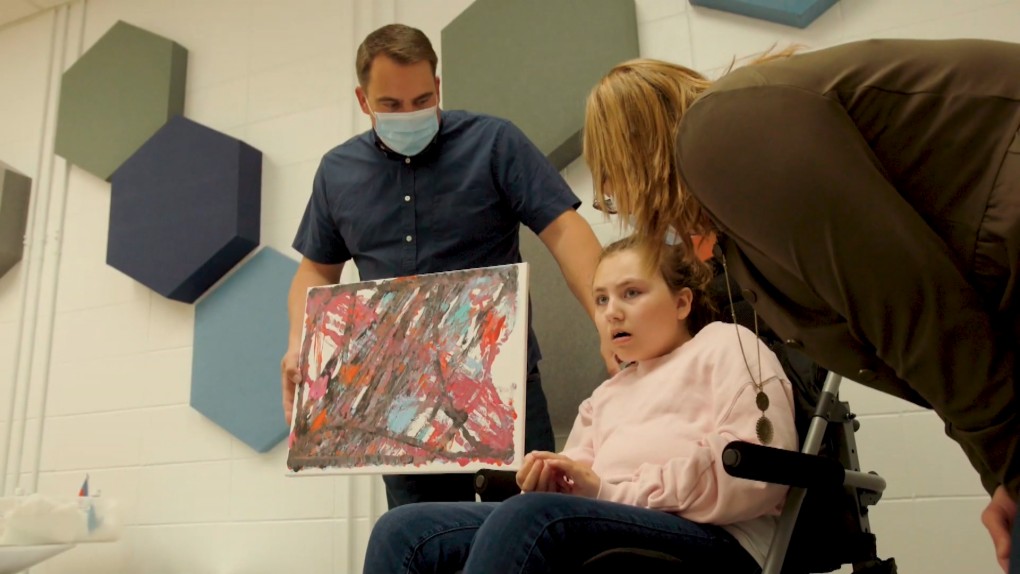'It's wonderful': Pediatric patients create art by controlling a computer with their minds
 Olivia Terry shows off a painting she created with brain computer interface technology.
Olivia Terry shows off a painting she created with brain computer interface technology.
Pediatric patients at the Glenrose Rehabilitation Hospital with restricted communication and physical control now have access to technology to help them play and make art.
The technology, called a brain computer interface, or BCI, allows a direct communication pathway between the brain’s electrical activity and an external device.
Users control BCI by thinking about specific things, which are translated into a command.
With practice, BCI is able to learn the specific patterns of a person’s brain to perform a task like controlling music or playing a game.
The technology has been around for decades, but it’s an emerging field of research for pediatrics.
“Patients can drive a wheelchair with BCI, play with remote controlled cars, or make changes to their environment by turning on lights or music,” said Corinne Tuck, occupational therapist and clinical practice lead for assistive technology at the Glenrose Rehabilitation Hospital in a written release.
“This technology is showing us just how smart these kids are. The applications we are using here is just the tip of the iceberg; BCI is one type of neuroadaptive technology whose potential we are only beginning to understand.”
Olivia Terry, 13, is one of the patients taking advantage of the technology.
Terry was diagnosed with Rett Syndrome when she was four years old. The neurological and developmental disorder causes a progressive loss of motor skills and speech.
She has lost the ability to speak and walk, but thanks to the technology she is able to create art.
She wears an external headset to detect her brain’s electrical activity. That information is analyzed and interpreted by a computer interface, which controls a Bluetooth enabled robot.
Olivia is able to use the device to indicate which paint colour she wants to use, which is then applied by a therapist to a motorized device. She then uses the device to create one-of-a-kind paintings.
 Olivia Terry uses brain computer interface to paint.
Olivia Terry uses brain computer interface to paint.
“Just really proud of herself, and just really feeling accepted, that she is doing something that everybody else is doing,” said Olivia’s mother Elana Terry.
She will also have access to BCI home kits with commercial headsets that will allow her to practice her skills at home.
“I’m sure some of her friends will come over to see what it is she can do. It just allows everyone to get together and do a fun activity any teenager will want to do,” said Elana.
The take-home kits can also be used for virtual appointments to reach patients who are unable to attend physical appointments for geographical reasons.
The Glenrose BCI program currently works in partnership with the Alberta Children’s Hospital in Calgary, and the Holland Bloorview Rehabilitation Hospital in Toronto.
Donors have contributed $385,000 to fund the technology.
With files from CTV News Edmonton's Nahreman Issa.
CTVNews.ca Top Stories

opinion Tom Mulcair: Prime Minister Justin Trudeau's train wreck of a final act
In his latest column for CTVNews.ca, former NDP leader and political analyst Tom Mulcair puts a spotlight on the 'spectacular failure' of Prime Minister Justin Trudeau's final act on the political stage.
B.C. mayor gets calls from across Canada about 'crazy' plan to recruit doctors
A British Columbia community's "out-of-the-box" plan to ease its family doctor shortage by hiring physicians as city employees is sparking interest from across Canada, says Colwood Mayor Doug Kobayashi.
'There’s no support': Domestic abuse survivor shares difficulties leaving her relationship
An Edmonton woman who tried to flee an abusive relationship ended up back where she started in part due to a lack of shelter space.
opinion King Charles' Christmas: Who's in and who's out this year?
Christmas 2024 is set to be a Christmas like no other for the Royal Family, says royal commentator Afua Hagan. King Charles III has initiated the most important and significant transformation of royal Christmas celebrations in decades.
Baseball Hall of Famer Rickey Henderson dead at 65, reports say
Rickey Henderson, a Baseball Hall of Famer and Major League Baseball’s all-time stolen bases leader, is dead at 65, according to multiple reports.
Arizona third-grader saves choking friend
An Arizona third-grader is being recognized by his local fire department after saving a friend from choking.
Germans mourn the 5 killed and 200 injured in the apparent attack on a Christmas market
Germans on Saturday mourned the victims of an apparent attack in which authorities say a doctor drove into a busy outdoor Christmas market, killing five people, injuring 200 others and shaking the public’s sense of security at what would otherwise be a time of joy.
Blake Lively accuses 'It Ends With Us' director Justin Baldoni of harassment and smear campaign
Blake Lively has accused her 'It Ends With Us' director and co-star Justin Baldoni of sexual harassment on the set of the movie and a subsequent effort to “destroy' her reputation in a legal complaint.
Oysters distributed in B.C., Alberta, Ontario recalled for norovirus contamination
The Canadian Food Inspection Agency has issued a recall due to possible norovirus contamination of certain oysters distributed in British Columbia, Alberta and Ontario.


































